Electric Takes the Lead
Electric vehicles are no longer the future they’re the present. Global adoption rates are hitting all time highs, driven by government incentives, stricter emissions regulations, and a real shift in consumer priorities. From Norway to China, EVs are quickly edging out combustion engines, especially in urban markets where charging infrastructure is scaling up fast.
On the tech front, battery breakthroughs are reshaping what’s possible. Faster charging, longer range, and better reliability mean EVs are catching up to or surpassing traditional options in both convenience and performance. Solid state batteries are inching closer to commercial viability, promising weight reductions and shorter charge times that could redefine the daily commute.
For legacy automakers, this shift is more than just a product tweak it’s a total supply chain overhaul. Established factories are retooling or closing altogether. Companies are racing to secure rare earth materials, rethink sourcing strategies, and partner with battery tech firms. Those who adapt quickly are seizing market share. Those who drag their feet? They’re watching it slip away, fast.
Automation Becomes Mainstream
Autonomous driving is no longer a side project it’s becoming a pillar of how cars are built and sold. In 2026, breakthroughs in AI perception, sensor fusion, and edge computing are making vehicles smarter and faster to respond than ever. We’re seeing Level 3 and Level 4 autonomy move from pilot programs to real world deployment, especially in controlled environments like highways and urban test zones.
Regulations are also shifting gears. Governments across Europe, North America, and parts of Asia are loosening restrictions on semi autonomous functionalities while drafting standards for full autonomy. Expect to see updated safety frameworks and licensing models as policymakers play catch up with the tech.
Meanwhile, public sentiment is evolving. Consumers were hesitant at first, but trust is growing thanks in part to clearer marketing, consistent performance, and positive early adopter feedback. We aren’t at full self driving ubiquity yet, but the roadblocks are fewer, the benefits clearer, and the pace quicker. For automakers and mobility firms, sitting on the sidelines is no longer an option.
Connectivity Drives Change
Cars aren’t just machines anymore they’re data hubs on wheels. In 2026, the smart car doesn’t just connect to your phone it connects to everything. Vehicles now sync with traffic systems, parking, weather alerts, even your coffee order. This growing web of connectivity positions the car as a mobile ecosystem, with software platforms as important as the drivetrain.
Integration with smart cities is the next frontier. Imagine your vehicle automatically rerouting you past roadwork, reserving a parking spot two blocks ahead, or adjusting its energy usage based on nearby charging station availability. It’s not futuristic fiction it’s the emerging standard.
But data doesn’t come without a price. With more systems talking to each other, the risks grow. Who controls the flow of data? Who owns it? Consumers and regulators are asking tougher questions about privacy, surveillance, and algorithmic decision making. Automakers need to balance seamless connectivity with airtight security and clear user control. In this new landscape, cars aren’t just driving they’re uploading, analyzing, and learning, every step of the way.
Design in the Age of Sustainability

Vehicle design is undergoing a transformative shift, driven by sustainability, efficiency, and evolving consumer values. The next generation of automobiles will not only look different they’ll be built differently, too.
A Shift Toward Recyclables and Minimalism
Modern automotive design increasingly prioritizes environmental impact. Both interior and exterior elements are seeing a push toward sustainably sourced, renewable, or recycled materials.
Key trends include:
Use of biodegradable or recycled fabrics in seating and interiors
Shift away from chrome and synthetic finishes toward natural looking alternatives
Simplified dashboard layouts to reduce material use and electronic waste
Designers are embracing minimalism not just for aesthetics, but to make vehicles lighter, more efficient, and easier to recycle at the end of their lifecycle.
Aerodynamics Meets Aesthetics
Efficiency isn’t just about what’s under the hood. Exterior design is being honed to reduce drag and improve range, particularly for electric vehicles (EVs).
How aerodynamics is shaping design:
Smooth silhouettes and flush mounted handles or lights to enhance airflow
Fewer decorative elements; more functional contouring
Adaptive design features like dynamic grilles and retractable spoilers
The challenge for manufacturers lies in balancing aerodynamic function with visual appeal without sacrificing brand identity.
Deeper Insight
For a more detailed look at how sustainability, electrification, and automation are converging in future car design, check out this comprehensive guide:
Top Trends in Car Design for the Next Decade
Mobility on Demand
The idea of owning a car 365 days a year to use it for weekend errands is wearing thin. Enter subscription based car ownership. Pay monthly, swap models when you want, and skip the commitment. It’s like Netflix only for wheels. The appeal? Flexibility, especially for younger drivers and urban nomads who want access without ownership headaches.
Car sharing and on demand platforms are also leveling up. Whether it’s a weekend trip or just grabbing groceries, users are leaning into the convenience. Brands like Zipcar and Turo are expanding offerings, while startups are flooding the space with hyperlocal options.
All of this is pushing automakers to rethink the product itself. A sedan designed to sit in someone’s driveway for ten years? Outdated. OEMs are now exploring modular designs, extended life interiors, and vehicles engineered for high turnover use cases. It’s not just what kind of car you drive but how, when, and why you access it that’s reshaping automotive strategy.
Industry Wide Collaboration
The line between a tech company and a car company has officially blurred. In 2026, co development isn’t optional it’s the baseline. Automakers are plugging into the software world fast, teaming up with chipmakers, AI firms, and connectivity startups. The goal? Smarter, safer, more adaptable vehicles. Think fewer multi year product cycles and more real time updates. Apple, Google, and Nvidia aren’t just vendors anymore they’re partners shaping the core DNA of the next gen car.
Meanwhile, the industry is consolidating. Legacy brands are merging to stay relevant or buying up mobility tech to catch up. Big names like Stellantis, Hyundai, and Ford are either joining forces or pulling in rising edge startups to keep their future proofing plans on track. It’s survival of the fastest.
But the scene isn’t just full of big names. New players are cutting in. Think Southeast Asian electric vehicle startups, autonomous delivery platforms, and software first electric truck makers. Agility and innovation are giving them a seat at the adult table, challenging the old guard to move faster and think smarter.
Collaboration used to be a buzzword. Now it’s the business model.
Preparing for What’s Next
The ground is shifting under everyone from the factory floor to the investor’s boardroom to the driver behind the wheel. Adaptation isn’t optional anymore.
Manufacturers need to double down on flexible production systems that can pivot with tech cycles. That means fewer long lead times, more modular platforms, and a greater focus on digital services layered over hardware. Automotive supply chains, once rooted in predictability, now need to embrace volatility and speed.
Investors should stop chasing the next flash in the pan EV startup and think long term. Companies solving for battery sustainability, domestic manufacturing, and scalable infrastructure are the ones that will matter five years from now not necessarily the ones with slick ad campaigns. Patience and data driven optimism will go a lot further than hype.
For drivers, the era of passive ownership is closing fast. Learning how to interface with evolving vehicle tech dash integrated apps, autonomous features, semiautomated maintenance is becoming the new normal. Drivers aren’t just consumers anymore; they’re data participants.
The labor force can’t be left behind either. Engineers, software devs, and sustainability experts are in traditional wrench turners will need re skilling. Training programs must expand beyond mechanical know how to cover automation, machine learning, and sustainable design.
This is the decade to think in systems, not silos. Flashy tech won’t carry the industry if it can’t scale responsibly. The future belongs to those who commit to deep, steady transformation.
For a closer look at the role of design in this shift, see: future car design

